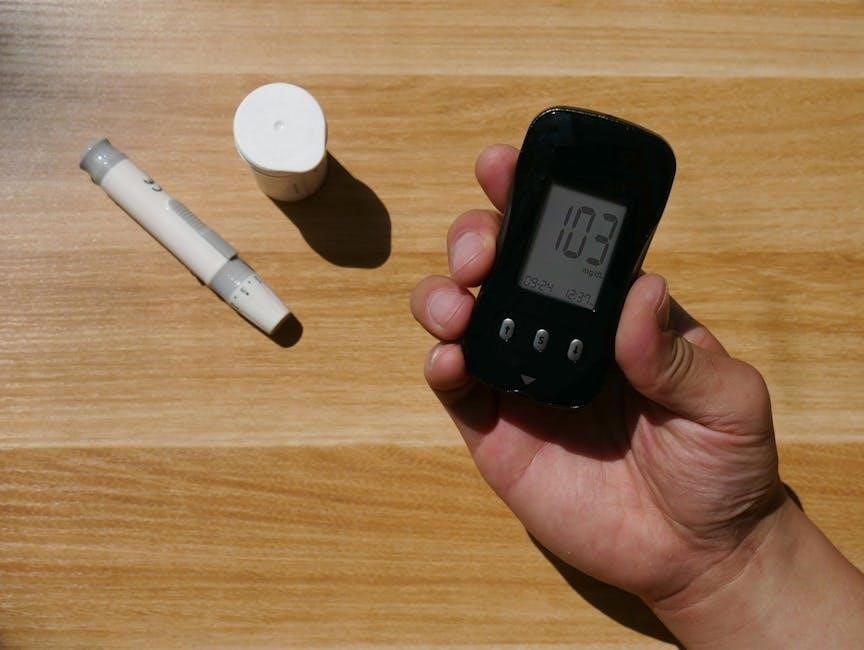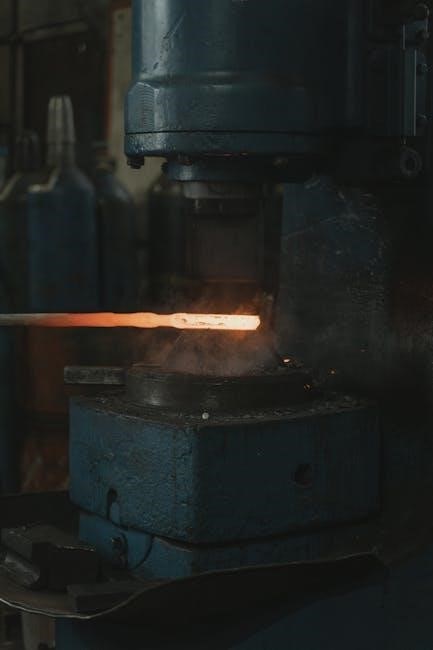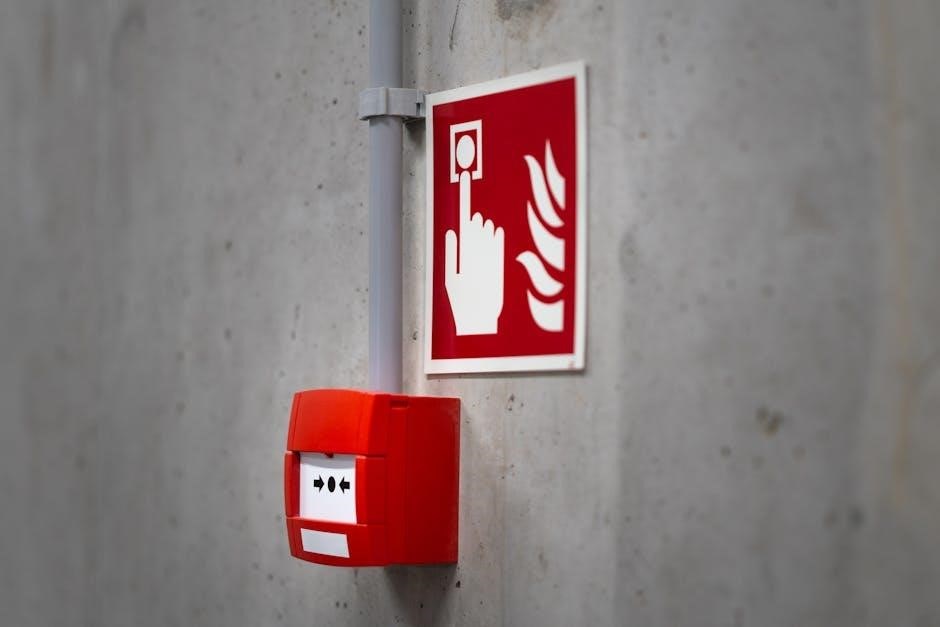The Presto Pressure Cooker Canner is a versatile kitchen appliance designed for pressure cooking and canning, offering efficient meal preparation and safe food preservation solutions for home use․
1․1 Overview of the Presto Pressure Cooker Canner
The Presto Pressure Cooker Canner is a dual-purpose appliance designed for both pressure cooking and canning, making it a versatile addition to any kitchen․ It offers a large capacity, typically accommodating multiple quart jars, and is constructed from durable materials like aluminum for efficient heat distribution․ The device features a built-in pressure gauge, ensuring precise control during cooking and canning processes․ It is ideal for preparing a wide variety of foods, including meats, vegetables, and seafood, while also enabling safe food preservation․ The Presto Pressure Cooker Canner is known for its ease of use, efficiency, and ability to save time while maintaining nutrient-rich meals․ Its compact design and secure locking mechanism further enhance its functionality and safety․

1․2 Importance of Using a Pressure Canner for Home Preservation
Using a pressure canner like the Presto model is essential for safely preserving low-acid foods such as meats, poultry, and vegetables․ Unlike boiling water bath canners, pressure canners reach high temperatures necessary to kill harmful bacteria and ensure food safety․ The USDA recommends pressure canning as the only reliable method for preserving these foods at home․ This method prevents spoilage, retains nutrients, and allows year-round enjoyment of seasonal produce․ By following the Presto Pressure Canner manual, users can achieve consistent results and maintain the quality of their preserved foods․ This makes it a vital tool for home food preservation, offering both convenience and peace of mind․

Safety Precautions and Guidelines
Adhere to the Presto Pressure Canner manual guidelines to prevent accidents․ Never place the canner in a heated oven or use it improperly, as this can cause harm․ Always follow safety instructions to ensure safe operation․
2․1 Essential Safety Tips for Pressure Canning
Safety is paramount when using the Presto Pressure Canner․ Always follow the manufacturer’s guidelines to avoid accidents․ Ensure the pressure canner is placed on a stable, heat-resistant surface, away from children․ Never leave the canner unattended during operation․ Before use, inspect the gasket and sealing ring for wear or damage, replacing them if necessary․ Avoid overfilling the canner, as this can lead to blockages and potential hazards․ Keep the vent pipe clear to allow steam to escape properly․ Always allow the pressure to drop naturally before opening the lid to prevent scalding from steam․ Regular maintenance and pre-use checks are crucial for safe and effective canning․
2․2 Understanding Pressure Canner Parts and Their Functions
The Presto Pressure Canner consists of several key components designed for safe and efficient operation․ The lid seals the canner and features a pressure gauge to monitor internal pressure․ The venting system, including the vent pipe and regulating valve, controls steam release․ The gasket ensures a tight seal between the lid and base, while the locking mechanism secures the lid in place․ The cooker base holds the food and liquid, and the handles provide easy lifting․ Regular inspection of these parts is essential for maintaining safety and functionality․ Understanding each component’s role helps users operate the canner effectively and troubleshoot issues when they arise․
2․3 Pre-Use Checks and Maintenance for Safe Operation
Before using the Presto Pressure Canner, perform essential checks to ensure safe operation․ Inspect the gasket for wear or cracks and replace it if damaged․ Check the vent pipe and pressure gauge for blockages or malfunctions․ Clean the canner thoroughly, paying attention to the sealing surfaces and handles․ Regularly sanitize all parts to prevent contamination․ After use, dry the canner to avoid rust․ Store the unit in a cool, dry place, ensuring all components are secure․ Proper maintenance extends the lifespan of the canner and ensures reliable performance․ Always refer to the manual for specific care instructions to maintain safety and efficiency during pressure canning and cooking․

Operating Instructions for Pressure Canning
Process foods at 11 pounds pressure for pints (20 minutes) and quarts (25 minutes)․ Adjust for altitude as per guidelines․ Always follow USDA recommendations for safe canning practices․
3․1 Step-by-Step Guide to Pressure Canning
Begin by preparing jars, lids, and food according to USDA guidelines․ Fill jars, leaving recommended headspace․ Ensure lids are clean and properly sealed․ Place jars in the canner, adding water to the recommended level․ Secure the lid and vent pipe․ Heat on high until steam exits steadily, then close the vent․ Process at 11 pounds pressure for the recommended time (20 minutes for pints, 25 for quarts)․ After processing, turn off heat and let pressure drop naturally․ Remove jars carefully and let them cool․ Check seals after 24 hours․ Always follow altitude adjustments and safe canning practices to ensure food safety and longevity․
3․2 Recommended Pressures and Processing Times
For safe and effective pressure canning, the Presto Pressure Canner operates at a standard pressure of 11 pounds per square inch (PSI)․ Processing times vary depending on the food type and jar size․ Pints typically require 20 minutes, while quarts need 25 minutes․ Always consult the USDA guidelines for specific food recommendations․ Adjustments are necessary for high altitudes, as pressure increases with elevation․ Refer to the provided altitude chart in the manual for precise adjustments․ Processing times may vary slightly for different foods, such as meats, vegetables, or seafood․ Ensure all foods are properly prepared and packed to avoid underprocessing․ Adhering to these guidelines ensures safe, high-quality canned goods․ Always follow the manual for detailed instructions․
3․3 Adjusting for High Altitude Canning
High-altitude canning requires adjustments to ensure safe and effective food preservation․ At elevations above 2,000 feet, water boils at a lower temperature, requiring increased pressure to achieve the necessary sterilization․ The Presto Pressure Canner manual recommends increasing the pressure setting according to altitude․ For example, at 2,000–2,400 feet, use 12 PSI, and at 2,400–3,000 feet, use 15 PSI․ Always refer to the altitude chart provided in the manual for precise adjustments․ Failure to adjust pressure at high altitudes can result in underprocessed food, posing safety risks․ Proper altitude adjustments ensure food is heated to a safe temperature to kill bacteria and extend shelf life․ Follow the USDA guidelines and your Presto manual for accurate high-altitude canning procedures to maintain food safety and quality․

Operating Instructions for Pressure Cooking
Follow complete instructions for pressure cooking, starting on page 21, to ensure safe and efficient meal preparation with your Presto Pressure Cooker Canner․
4․1 Quick Start Guide to Pressure Cooking
To begin pressure cooking with your Presto Pressure Cooker Canner, follow these easy steps:
- Assemble the cooker by ensuring all parts are securely locked in place․
- Add the recommended amount of liquid to the pot to prevent overfilling․
- Place the food in the cooker, ensuring it does not block the steam vent․
- Close and lock the lid, making sure the pressure regulator is in place․
- Set the burner to high heat until the pressure gauge indicates the desired pressure․
- Reduce heat to maintain the pressure and start timing according to the recipe․
- After cooking, allow the pressure to release naturally or use the quick-release method․
Always refer to the manual for specific instructions and safety guidelines to ensure optimal results․
4․2 Cooking Times and Liquid Requirements
Adequate liquid and precise cooking times are crucial for optimal pressure cooking results․ Generally, add 2-3 cups of liquid for most recipes to ensure proper steam generation and pressure buildup․ Cooking times vary based on the food type and desired texture․ For example, vegetables typically require 5-15 minutes, while meats and grains may need 20-40 minutes․ Avoid overfilling the cooker, as this can obstruct steam flow and affect pressure regulation․ Always consult the Presto manual for specific guidelines, as processing times may differ for high-altitude cooking․ Ensuring the correct liquid levels and adhering to recommended times guarantees evenly cooked meals and prevents undercooked or overcooked outcomes․
4․3 Tips for Achieving Perfect Texture and Flavor

For optimal texture and flavor, sear meats or vegetables before pressure cooking to lock in juices and enhance taste․ Add aromatics like garlic, onions, or spices to infuse flavors․ Use the recommended liquid ratio to avoid overcooking or drying out food․ Avoid overcrowding the pot, as this can prevent even cooking․ For delicate foods, use the quick-release method to stop cooking immediately․ For heartier dishes, allow natural pressure release to retain moisture and texture․ Acidity from tomatoes or vinegar can balance flavors, while marinating ingredients beforehand adds depth․ Experiment with herbs and spices to customize dishes, ensuring a perfect blend of taste and texture every time․

Recipes for Pressure Canning and Cooking
Explore a variety of recipes for pressure canning and cooking, including classic vegetables, hearty meats, and flavorful seafood, tailored to enhance your culinary skills and nutrition․
5․1 Classic Recipes for Canned Vegetables
Discover timeless recipes for canning vegetables using the Presto Pressure Canner, perfect for preserving fresh produce year-round․ Classic options include green beans, carrots, and corn, ensuring flavorful and nutritious results․ These recipes emphasize simplicity, allowing the natural taste of vegetables to shine․ Essential steps like sterilization, packing, and processing times are detailed to ensure safety and quality․ The Presto manual provides charts for altitude adjustments, crucial for achieving proper canning conditions․ Whether you’re preserving summer harvests or experimenting with herbs and spices, these recipes offer a reliable foundation․ With the Presto Pressure Canner, enjoy homemade canned vegetables that retain their nutrients and flavor, making meal prep and storage effortless and rewarding․
5․2 Pressure Cooker Recipes for Meats and Poultry
Explore delicious and quick pressure cooker recipes for meats and poultry using the Presto Pressure Canner․ Achieve tender, flavorful results with minimal effort․ Popular options include chicken stews, beef roasts, and pork chili․ The pressure cooker excels at breaking down connective tissues, turning tough cuts into mouthwatering dishes․ Recipes often highlight the importance of seasoning and liquid ratios for optimal flavor․ From hearty soups to fall-apart pot roasts, these meals are perfect for weeknight dinners or special occasions․ The Presto Pressure Canner’s even cooking ensures consistent results, while sealing in nutrients for healthier meals․ Discover how to create moist, savory meats and poultry with precise cooking times and techniques․ Elevate your home cooking with these satisfying, easy-to-follow recipes․
5․3 Seafood and Fish Recipes for the Presto Canner
Discover how to prepare seafood and fish to perfection using the Presto Pressure Canner․ This versatile appliance excels at cooking delicate fish and seafood, ensuring tender, flavorful results․ Popular recipes include shrimp, salmon, and cod, all of which can be cooked to perfection in minutes․ The pressure cooker’s ability to lock in moisture and flavor makes it ideal for seafood stews, chowders, and poached fish dishes․ With precise temperature control, you can achieve restaurant-quality results at home․ Explore a variety of seafood recipes tailored for the Presto Canner, designed to enhance taste and texture while maintaining nutritional value․ Whether you prefer mild or spicy flavors, these recipes offer endless possibilities for seafood lovers․

Maintenance and Troubleshooting
Regularly clean and inspect the Presto Pressure Cooker Canner to ensure optimal performance․ Check gaskets, valves, and seals for wear, and replace parts as needed to maintain safety and efficiency․
6․1 Cleaning and Storing the Presto Pressure Canner
Regular cleaning and proper storage are essential for maintaining the Presto Pressure Canner’s performance and longevity․ After each use, wash the canner with warm soapy water, paying attention to the gasket, valves, and vents to prevent food residue buildup․ Avoid using abrasive cleaners or scourers, as they may damage the finish․ Dry the canner thoroughly, especially the lid and gasket, to prevent rust or mold․ Store the canner in a cool, dry place, separating the lid from the base to ensure airflow․ For seasonal storage, apply a thin layer of cooking oil to moving parts and wrap them in plastic to protect against dust and moisture․ Always refer to the manual for specific cleaning instructions to maintain safety and functionality․
6․2 Common Issues and How to Fix Them
Common issues with the Presto Pressure Canner include stuck valves, faulty gaskets, or clogged vents․ To address these, first, ensure all parts are clean and free of food residue․ If the valve is stuck, soak it in warm soapy water and gently scrub․ For gasket issues, inspect for wear or cracks and replace if necessary․ Clogged vents can be cleared with a small brush or toothpick․ If the canner fails to pressurize, check the lid alignment and ensure the gasket is properly seated․ Refer to the manual for troubleshooting specific error conditions․ If problems persist, contact Presto Consumer Service for assistance․ Regular maintenance and proper care can prevent many of these issues, ensuring optimal performance and safety․
6․3 When to Replace Parts and Where to Find Them
Replace Presto Pressure Canner parts when they show signs of wear, such as cracks, warping, or reduced performance․ Gaskets and seals should be replaced every 2-3 years or if they lose flexibility․ Valves and locking mechanisms should be replaced if they malfunction or leak․ For replacement parts, visit the official Presto website or authorized retailers․ You can also contact Presto Consumer Service directly for assistance․ Ensure to use genuine Presto parts to maintain safety and functionality․ Regularly inspecting and replacing worn components will extend the lifespan of your canner and ensure reliable operation․ Always refer to the manual for compatible part numbers and installation instructions․

Understanding the Presto Pressure Canner Manual
The Presto Pressure Canner Manual provides detailed instructions, safety guidelines, and recipes for pressure canning and cooking․ It is available for download as a PDF online․
7․1 Navigating the Manual for Easy Reference
The Presto Pressure Canner Manual is designed to be user-friendly, with clear sections and an index for quick access to specific topics․ The table of contents allows users to easily locate instructions for pressure canning, cooking, maintenance, and troubleshooting․ Key sections are highlighted for safety precautions and essential operating guidelines․ The manual also includes a detailed troubleshooting guide and quick-reference charts for processing times and pressures․ Digital versions of the manual, available in PDF format, often include bookmarks and search functions for faster navigation․ This ensures users can find the information they need without flipping through pages․ The manual’s organized structure makes it an invaluable resource for both new and experienced users, ensuring safe and effective use of the Presto Pressure Canner․
7․2 Key Sections Every User Should Know
The Presto Pressure Canner Manual includes essential sections that every user should familiarize themselves with for safe and effective operation․ Key sections include safety precautions, operating instructions, and troubleshooting guides․ The safety section outlines critical guidelines to prevent accidents, such as proper lid alignment and pressure release procedures․ Operating instructions provide step-by-step guides for pressure canning and cooking, including recommended pressures and processing times․ Troubleshooting sections help users identify and resolve common issues, ensuring optimal performance․ Additionally, the manual includes recipe sections and maintenance tips to extend the appliance’s lifespan․ Understanding these sections is crucial for maximizing the appliance’s potential while ensuring safety and efficiency in food preservation and preparation․
7․3 Downloading and Accessing the PDF Manual
The Presto Pressure Cooker Canner manual is readily available for download as a PDF file, ensuring easy access to instructions and guidelines․ Users can visit the official Presto website or authorized online platforms to find the correct manual for their specific model․ Simply enter the model number, such as 01655 or 463238218, to locate the corresponding PDF․ The manual includes detailed instructions for pressure canning, cooking, and maintenance, along with troubleshooting tips and recipes․ Downloading the PDF allows users to access the information offline, making it convenient for reference at any time․ This ensures that users can fully utilize their appliance safely and effectively, adhering to the manufacturer’s recommendations for optimal performance and food preservation․ The PDF format is user-friendly and compatible with most devices, providing a seamless experience for all users․

Additional Resources and Support
Explore online forums, user communities, and Presto’s official website for comprehensive support, including troubleshooting guides, accessory recommendations, and direct customer service contact information for assistance․
8․1 Online Communities and Forums for Presto Users
Active online forums and communities dedicated to Presto users provide valuable support and resources․ These platforms allow users to share experiences, ask questions, and gain insights from experienced home canners and cooks․ Websites like Facebook groups and Reddit forums host discussions on troubleshooting, recipes, and tips for optimal use of the Presto Pressure Cooker Canner․ Additionally, official Presto forums offer direct access to expert advice and official updates․ These communities are a great way to connect with fellow users, resolve common issues, and enhance your canning and cooking skills․ Many threads also include links to downloadable manuals, recipes, and step-by-step guides for reference․ Engaging with these forums can significantly improve your overall experience with the Presto appliance․
8․2 Contacting Presto Consumer Service
For assistance with your Presto Pressure Cooker Canner, you can contact Presto Consumer Service directly․ Their support team is available to address questions, troubleshooting, and concerns․ You can reach them by phone at 1-800-877-0441 or via email at consumer․service@presto․cc․ Their office hours are Monday through Friday, 8 AM to 5 PM CST․ Additionally, Presto’s official website provides a ‘Contact Us’ section where you can submit inquiries or feedback․ Make sure to have your model number and a detailed description of your issue ready for faster resolution․ Presto’s customer service is committed to helping you make the most of your appliance, ensuring safe and effective use for both pressure cooking and canning․
8․3 Recommended Accessories for Enhanced Use
To maximize the functionality of your Presto Pressure Cooker Canner, consider investing in recommended accessories․ A pressure regulator ensures consistent pressure control, while a canning rack prevents jars from touching the bottom and promotes even heating․ Canning jars, lids, and rings are essential for safe food preservation․ Additionally, a replacement gasket is crucial for maintaining a proper seal․ For convenience, Presto offers recipe books tailored for pressure cooking and canning, providing inspiration for diverse meals․ These accessories enhance both the efficiency and safety of your Presto appliance, making it a versatile tool for home cooking and food preservation․ Always ensure accessories are compatible with your specific Presto model for optimal performance․
